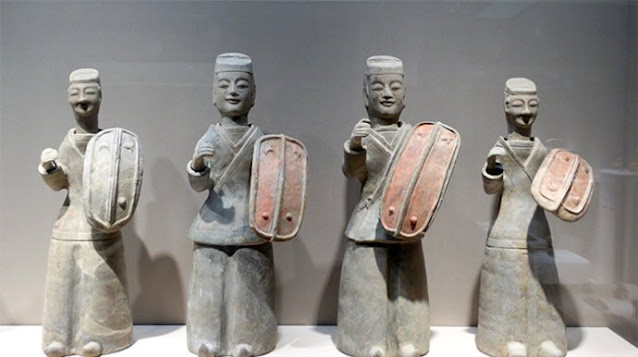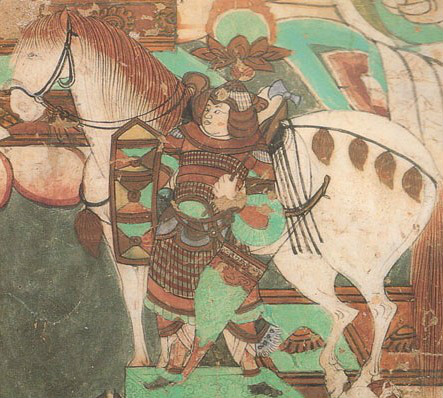MINOR UPDATE MARCH 4, 2024
The
Uprising of the Five Barbarians overran North China in 316 AD and caused the downfall of Western Jin Dynasty. The remnants fled southward and founded the Eastern Jin Dynasty, while the barbarians (and a handful of Han rulers) founded their own kingdoms in North China, collectively known as the
Sixteen Kingdoms. Eventually, the sixteen kingdoms reunified into
Northern Wei, first of the Northern Dynasties, under
Xianbei ruler Tuoba Gui (拓跋珪), while Eastern Jin Dynasty was overthrown by
Liu Song Dynasty, first of the Southern Dynasties,
under Han ruler Liu Yu (劉裕).
Thus China entered a period of turmoil and constant struggle known as Northern and Southern Dynasties. Due to nomadic influences, this period saw many drastic changes to Chinese military tactics and ultra-heavy cataphracts came to dominate the battlefield. Ironically, Chinese shield did not evolve as drastically as the previous dynasties. Both Northern and Southern Dynasties inherited the same type of long shield from Jin period, although as time went on Northern and Southern shield designs gradually diverged from each other.
Northern Dynasties (386 AD – 581 AD)
Despite their nomadic/barbarian origin, Northern Dynasties adopted and inherited much of the military legacy of Western Jin Dynasty, which they overthrew.
Oblong long shield with zoomorphic shield boss
 |
| Section of a mural depicting an armoured Northern Wei warrior with a long shield. Datong, China. |
 |
| Several figurines with Jin Dynasty-style long shields discovered at a Northern Dynasties tomb at Dongbaliwa, Shandong, China. |
While Jin Dynasty-style long shield was still in common use, a new type of long shield came into prominence in the Northern Dynasties. This new shield, still mostly oblong in shape, was much larger than Jin Dynasty-style long shield, and often (but not always) came with a large zoomorphic shield boss at the centre of the shield.
 |
| Northern Dynasties figurine propping a large long shield. |
This type of shield appears not only larger but also heavier than the shields of previous dynasties, as Northern Dynasties tomb figurines often stand in a upright posture and rest their shields on the ground (see picture above), a departure from earlier tomb figurines that hand-carry their shields. This is presumably due to the changing nature of warfare during this period. As heavily armoured and saddled cataphract took centre stage, foot soldiers were relegated to a more static and supportive role, and shield became less manoeuvrable as a result.
It should be noted that despite the presumed increase in weight, the shield was still carried by hand during combat.
Southern Dynasties (420 AD – 589 AD)
Like their more barbaric counterparts, Southern Dynasties also succeeded the military legacy of Eastern Jin Dynasty. Nevertheless, they were not as wealthy as Northern Dynasties, nor could they maintain anywhere near as many heavy cataphracts. As such, Southern Dynasties took a more balanced, combined arms (of infantry, cavalry, war wagon, and navy) approach to warfare, and Southern Dynasties shield developed along a different path from Northern Dynasties shield.
Hexagonal long shield
 |
| Southern Dynasties figurines with Jin Dynasty-style long shields. |
Like Northern Dynasties, Jin Dynasty-style long shield continued to see common use. While Southern Dynasties military did not change as drastically as the Northern Dynasties, they too had to adapt to the new threat coming from the north. Southern Dynasties also maintained a number of heavy cataphracts, although they were often of lesser number and quality than those of Northern Dynasties. Consequently, infantry continued to play a more important and active role in Southern Dynasties warfare.
 |
| Section of the Dunhuang mural 'Conversion to Buddhism of Five Hundred Robbers', depicting shielded "robbers" (dressed in the manner of Southern Dynasties infantry) fighting against heavily armoured cataphracts. |
 |
Another section of the Dunhuang mural 'Conversion to Buddhism of Five Hundred Robbers', depicting a "robber" armed with a half-trident fighting behind a propped shield.
|
 |
| Brick relief depicting several Southern Dynasties infantry. Note that they walk in swordsman-longbowman pairs. Also note the asymmetric shape of the bows and the way they are carried are similar to Japanese bow. |
The continued importance of Southern Dynasties infantry was reflected on their shield design as well, as Jin Dynasty-style long shield was eventually superseded by a new hexagonal long shield. This new shield has a very unique shape—both concave and bent. The shield also became much longer than Jin Dynasty-style shield, but hardly any broader. Unlike their northern counterparts, unearthed Southern Dynasties figurines are still commonly depicted as hand-carrying their shields.
Sui Dynasty (581 AD – 618 AD)
After one and a half century of struggle, Northern and Southern Dynasties period came to an end with the South ended up on the losing side–Sui Dynasty, which succeeded the Northern Zhou, successfully conquered Southern Chen and finally reunified China. Nevertheless, Sui Dynasty was short-lived, lasting a mere thirty-nine years before it was succeeded by Tang Dynasty. Unsurprisingly, Chinese shield hardly changed during this period.
Hexagonal long shield
 |
| Two Sui Dynasty figurines wearing Northern Dynasties-style armours, but equipped with Southern Dynasties-style bend hexagonal shields. |
Despite its northern origin, Sui Dynasty already showed some signs of "Southernification", a trend that started during the Northern and Southern Dynasties period and would come into full force during Tang period. Many Southern Dynasties cultural elements, aesthetics, economic practises and academic and philosophical thoughts gradually seeped into, influenced, and even replaced those of Northern Dynasties.
Shield was no exception to this Southernification trend. Southern Dynasties-style hexagonal shield quickly displaced Northern Dynasties shield and became the predominant shield type.
Tang Dynasty and Five Dynasties and Ten Kingdoms period (618 AD – 979 AD)
While widely considered to be the zenith and golden age of Chinese civilisation, Chinese shield changed surprisingly little during this period. Hexagonal shield, only slightly modified, continued to see common use throughout the entire Tang period.
Pentagonal or hexagonal long shield
 |
| Section of a Dunhuang mural telling the legend of King Ajatashatru, depicting Tang swordsmen sparring with spearmen. Both pentagonal and hexagonal shields are depicted in the mural. |
Tang Dynasty long shield retained the polygonal shape of its predecessor. However, unlike Southern Dynasties-style hexagonal shield, Tang Dynasty long shield was flat (or even slightly convex) and straight. It no longer had prominent spine. Pentagonal shield also became just as popular as hexagonal shield during Tang period.
 |
| Yulin caves mural depicting a Tang cavalryman with a pentagonal long shield. Also note the rather large size of the horse. |
More decorated Tang Dynasty long shields were usually segmented into several rectangles and painted with simple primary colours.
Round or oval cavalry shield with five studs/bosses
 |
| Section of Dunhuang mural "Eight Kings Dividing the Relics" depicting early Tang light cavalry with round shields. |
Round cavalry shield, of possible Central Asian influence, also became popular during Tang period.
Hand shield
 |
| Section of a painted banner depicting an armoured Tang warrior with a hand shield. The banner is currently in the possession of British Museum. |
A new type of hand shield was also used during Tang period, although it was not as popular as the long shield. This type of hand shield appears to be a throwback to earlier designs.
Other blog posts in my Shield Evolution series:
Part 2: Northern and Southern Dynasties to Tang













Thank you for the shield series. Are you also thinking of doing same for sword, spear, etc?
ReplyDeleteIf I feel like it...actually sword or spear didn't change all that much if you ask me...
DeleteI'm actually really enjoying this series! It's very detailed. May I ask, how important where shields in the late 15th and 16th century, during the Ming, for heavy armored troops? I'm also looking forward to read the next part.
ReplyDeleteArmoured troops (including Ming cavalry, whom were generally the most heavily armoured) still used shields throughout Ming period. Stay tuned for the next part!
DeleteNotable Ming (infantry) shields were the round rattan shields which continued to be used well into the Qing Dynasty, and the polygonal large shield. All of which would be usually decorated with mystical creature and animal motifs.
ReplyDelete